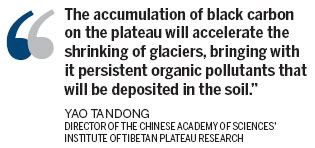Third Pole glaciers shrinking, affected by black carbon
Updated: 2013-03-25 07:35
By Wu Wencong (China Daily)
|
||||||||
About 90 percent of glaciers in the Third Pole region are shrinking, accelerated by black carbon being transferred from South Asia to the Tibetan Plateau, a top scientist has warned.
The Third Pole region, which is centered on the Tibetan Plateau and concerns the interests of the surrounding countries and regions, covers more than 5 million square kilometers and has an average altitude of more than 4,000 meters.
The area has the largest number of glaciers outside the polar regions and exerts a direct influence on the social and economic development of some of the most densely populated regions on earth, including China and India.
The glaciers are at the headwaters of many prominent Asian rivers.
Influenced by global warming, its alpine glaciers have seen drastic changes in recent years, such as thinning and shrinkage, which pose potential geological hazards to people both on and around the plateau.
Like Antarctica and the Arctic, the Third Pole is drawing increased attention from the international academic community, but the results of former international studies in this area are inconsistent, said Yao Tandong, director of the Chinese Academy of Sciences' Institute of Tibetan Plateau Research.
The scientist, a member of the Chinese People's Political Consultative Conference National Committee, said some people believe the glaciers will retreat and finally disappear by 2030, while others argue they will remain unchanged.
There are even people who argue that the glaciers have even moved forward, he said.
Researchers at Yao's institute say they can now draw a more comprehensive picture of the region, by showing data on the glaciers' status over the past 30 years. An investigation using topographic maps and satellite images revealed the retreat of 82 glaciers, area reduction by 7,090 glaciers and the mass-balance change of 15 glaciers.
"Systematic differences in glacier status are apparent from region to region, with the most pronounced shrinkage in the Himalayas, the southeastern part of the region.
Some of the glaciers there are very likely to disappear by 2030," Yao said.
"The shrinkage generally decreases from the Himalayas to the continental interior and is smallest in the western part. Some glaciers there are even growing."
He said changes in the glaciers will be accelerated if the planet continues to warm.
Potential consequences would be unsustainable water supplies from major rivers and geo-hazards, such as glacier lake expansion and flooding, which could threaten the well-being of people downstream.
Ongoing research over more than 30 years has also brought scientists a new understanding of pollution on the Tibetan Plateau, said Yao.
"There were two prevailing views in the past. One was that there was no pollution, the other was that the pollution must come from the east, if there was any at all."

But the latest investigations now show that black carbon generated from industrial production in South Asia is being taken to the Tibetan Plateau by the Indian monsoon in spring and summer.
The pollutants are coming from the west, not east, the scientist said.
"The accumulation of black carbon on the plateau will accelerate the shrinking of glaciers, bringing with it persistent organic pollutants that will be deposited in the soil."
wuwencong@chinadaily.com.cn
Related readings:
Tibetan plateau may be woolly rhino's evolutionary cradleWorld's 3rd Largest Glacier in China's Tibet
Top 6 most beautiful glaciers in China
China's glaciers melt fastened by global warming
Vanishing glaciers reveal the truth
Environment report warns of fast melting glaciers north and south

 Li Na on Time cover, makes influential 100 list
Li Na on Time cover, makes influential 100 list
 FBI releases photos of 2 Boston bombings suspects
FBI releases photos of 2 Boston bombings suspects
 World's wackiest hairstyles
World's wackiest hairstyles
 Sandstorms strike Northwest China
Sandstorms strike Northwest China
 Never-seen photos of Madonna on display
Never-seen photos of Madonna on display
 H7N9 outbreak linked to waterfowl migration
H7N9 outbreak linked to waterfowl migration
 Dozens feared dead in Texas plant blast
Dozens feared dead in Texas plant blast
 Venezuelan court rules out manual votes counting
Venezuelan court rules out manual votes counting
Most Viewed
Editor's Picks

|

|

|

|

|

|
Today's Top News
Boston bombing suspect reported cornered on boat
7.0-magnitude quake hits Sichuan
Cross-talk artist helps to spread the word
'Green' awareness levels drop in Beijing
Palace Museum spruces up
First couple on Time's list of most influential
H7N9 flu transmission studied
Trading channels 'need to broaden'
US Weekly

|

|







